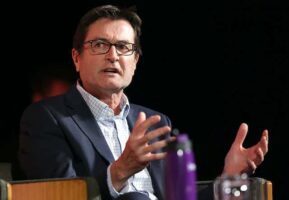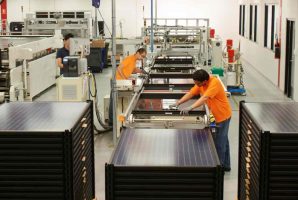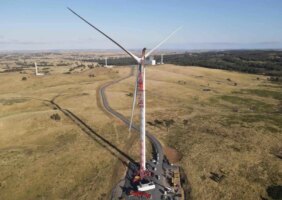Australia’s biggest wind farm is now all but mechanically complete. The last of the 149 turbines at the 530MW Stockyard Hill facility in central Victoria has been installed, three substations are complete and energised, and yet – more than one year after the original timetable – the facility is not producing power.
But don’t expect to find out why. Both the Australian Energy Market Operator and Goldwind, the developer of the project and now joint owner along with the Qatari investor Nebras Power, are not commenting on the issues at Australia’s biggest wind project.
AEMO has confirmed only that Stockyard Hill has failed so far to obtain the registration needed to be allowed to send power into the grid and then start the months-long commissioning process, that will see the project gradually test all turbines and then increase its capacity after passing tests at various “hold points.” AEMO’s latest registration data shows that – as of December 15 – it was still not registered.
Goldwind has made no formal comment on the issue of registration, despite several requests. But it did confirm it is not yet registered in a pubic construction update issued last Friday on the Stockyard Hill website.
“The commissioning of the project continues to make strong progress, with the three substations fully completed and capable of exporting power to the grid through the 500kV Haunted Gully Terminal Station once the project is registered by AEMO,” the update says.
“Final commissioning and project completion activities will continue into early 2021.”
The lack of clarity over the delays, and the reasons for it, are typical of the Australian electricity market, where many of the inner workings are hidden from view – a situation that will worsen as more listed companies are taken private.
Stockyard Hill is just the latest, and by far the biggest, of any number of projects that have been delayed – either during construction or commissioning – over the last few years. And the true reasons are rarely explained.
Some constraints and delays have been sheeted down to broader network issues, such as the lack of network capacity, the lack of system strength, the risk of voltage oscillations, and potential congestion problems.
But some individual projects have been held back dramatically, failing to obtain registration even after they have finished construction. One of the most notable is the Kennedy Energy Hub in far north Queensland, which would have been the world’s first wind, solar and battery hybrid facility, but for the fact that – nearly two years after its planned completion – it has still not been switched on. The reason has not been made clear.
The 200MW Sunraysia solar farm in NSW waited nearly a year for its registration (now obtained), leading to claims and cross claim in the courts between the owners and the contractors that then included the inverter supplier. But it is still not clear what the problem is or was.
What was, briefly, the country’s biggest solar farm – the 220MW Bungala facility in South Australia – had its second 110MW stage held for early a year at minimal output for what its owners obliquely referred to as “technical issues”. It never explained what these were – the unproven industry gossip was “harmonics” – but the issue now appears to have been solved.
The only reasons that these delays came to light was because their owners, and/or contractors, were publicly listed and obliged to notify investors of delays, losses or claims. Otherwise, little would be known.
Stockyard Hill was not expected to have any significant issues – Goldwind is a leading and successful builder and owner of many wind and some solar assets in Australia.
But like the 336MW Dundonnell wind farm, whose listed owner Tilt Renewables was told at the 11th hour that its full commissioning would be held back by “unanticipated” problems, the best bet is that it seems it has fallen victim of new modelling that has identified “issues” within the network.
That could be because it finds itself in an area of the grid that has seen many more renewable energy installations that have created new concerns, and it could be that Stockyard Hill is now required to conform to a later set of connection rules – which have been updated dozens of times in the last two years.
AEMO plays a dual role in Victoria, as both market operator and the authority responsible for grid connections (in the other states that connection role is played by the major transmission companies).
It is possible that the modelling has discovered issues that require changes to the set-up at Goldwind, possibly through software or inverter settings, or the need to install “reactive power” to deal with any issues.
Industry insiders say there is no doubt that generators are now being asked to demonstrate greater levels of capability than they have previously, even if some of the rules imposed by the local transmission companies or AEMA have been questioned.
But in this case we don’t know.
What we do know is that such delays are holding back production, with impacts on state targets, wholesale electricity prices and the market for LGCs (large scale generation certificates), which are higher than they would otherwise be.
Origin Energy, which announced what was then a record low price for wind energy in May, 2017, is not expecting to see any power produced until some time in 2021, according to its recent investor day presentation. When it does start delivering, that will amount to around 2 terrawatt hours a year, or about 1 per cent of total production in Australia’s main grid, and annual revenue of around $110 million for the wind farm.
Asked by RenewEconomy, Origin would not comment in detail on the issues at Stockyard Hill, saying only: “Origin looks forward to Stockyard Hill Wind Farm adding to our growing renewable supply in the near future.”










